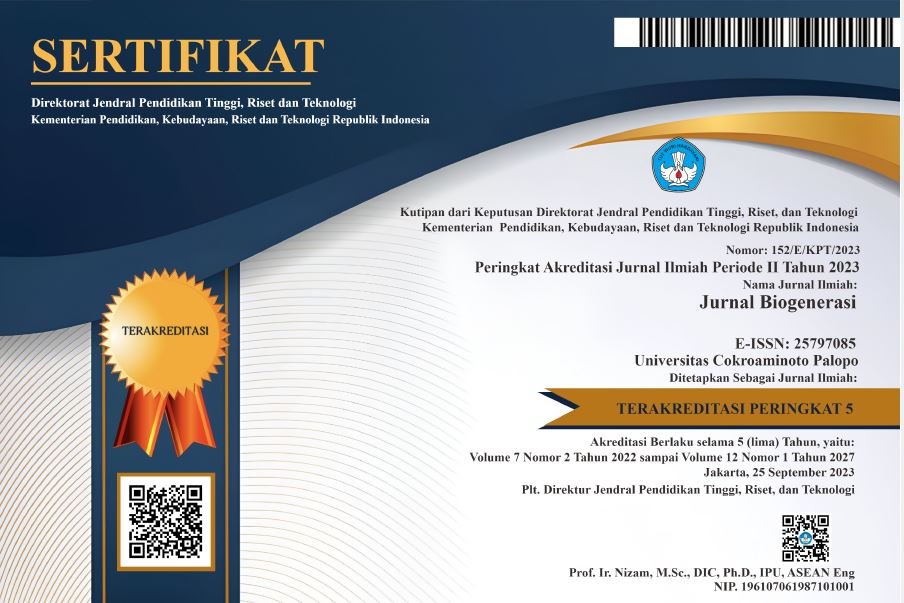PENGARUH FORMULASI FERTILIZER ANORGANIK DAN BIOLOGIKAL TERHADAP JUMLAH PHOSPHATE SOLUBILIZING BACTERIA, KANDUNGAN PHOSPHAT, DAN PRODUKTIVITAS HIDROPONIK PAKCOY
DOI:
https://doi.org/10.30605/biogenerasi.v6i2.1348Keywords:
biological inorganic fertilizer, number of bacteria, phosphate content, hydroponic pakcoy plantAbstract
The purpose of the study was to determine whether the combination of biological fertilizer and inorganic fertilizer had an effect on the amount of phosphate solubilizing bacteria, phosphorus content and hydroponic productivity of pakcoy. In hydroponic installations, inorganic fertilizers and biological fertilizers are applied to increase yields, because inorganic fertilizers provide nutrients and biological fertilizers produce plant phytohormones that promote plant growth. This research was conducted using a Randomized Block Design (RAK) which included 7 formulations of inorganiic fertilizers (100%, 75% and 50% concentrations) and biological fertilizers (100%, 75%, 50% and 25% concentrations). The test results prove that the formulation of inorganic fertilizers and biological fertilizers is not significantly different with the parameters of the amount of phosphate solubilizing bacteria, phosphorus content and productivity of pakcoy with hydroponic installations.
Tujuan penelitian adalah untuk mengetahui apakah perlakuan kombinasi fertilizer biologikal dan fertilizer anorganik berpengaruh terhadap jumlah phosphate solubilizing bacteria, kandungan phosfor dan produktivitas hidroponik pakcoy. Dalam instalasi hidroponik, fertilizer anorganik dan fertilizer biologikal diterapkan untuk meningkatkan hasil, karena fertilizer anorganik memberikan nutrisi dan fertilizer biologikal menghasilkan fitohormon tanaman yang mendorong pertumbuhan tanaman. Riset ini dilakukan dengan mengunakan Rancangan Acak Kelompok (RAK) yang meliputi 7 formulasi fertilizer anorganik (konsentrasi 100%, 75% dan 50%) dan fertilizer biologikal (konsentrasi 100%, 75%, 50% dan 25%). Hasil pengujian membuktikan bahwa formulasi fertilizer anorganik dan fertilizer biologikal tidak berbeda nyata dengan parameter jumlah phosphate solubilizing bacteria, kandungan fosfor dan produktivitas pakcoy dengan instalasi hidroponik.
Downloads
References
Astari, W., Purwani, K. I., & Anugerahani, W. (2014). Produktivitas Tanaman Tomat ( Solanum lycopersicum L.) Var. Tombatu di PT Petrokimia Gresik. Jurnal Sains Dan Seni Pomits, 2(1), 2–5.
Basuki, T.A. (2008). Pengaruh Macam Komposisi Hidroponik terhadap Pertumbuhan Hasil Selada (Lactuca sativa L.). Skripsi. Yogyakarta: Fakultas Pertanian Universitas Gadjah Mada.
Badan Pusat Statistik. (2014). Produksi sayuran pakcoy di Indonesia 2010-2013. Badan Pusat Statistik.
Blanco, & Baker. (2007). Interaction Between Plant and Beneficial Pseudomonas spp: Exploiting Bacterial Traits for Crop Pro- tection. (Rev. 92). Hh. 367-389.
Fitriatin, B.N., Yuniarti, A., Mulyani, O., Fauziah, F.S., & Tiara, M.D. (2009). Pengaruh Mikroba Pelarut Fosfat (MPF) dan Pupuk P terhadap P-Tersedia, Aktivitas Fosfatase, P Tanaman dan Hasil Padi Gogo (Oryza sativa L.) pada Ultisol. Jurnal Agrikultura, 20 (3): 210-215.
Husna. (2013). Pemanfaatan Pupuk Hayati (Pseudomonas flourescens) untuk Meningkatkan Efisiensi Pemupukan pada Tanaman Tomat. Skripsi. Lampung: Fakultas Pertanian Universitas Lampung.
Kartika. E., Yusuf, R. & Syakur, A. (2015). Pertumbuhan dan Hasil Tanaman Tomat (Lycopersicum esculentum Mill.) pada Berbagai Persentase Naungan. Jurnal Agrotekbis, 3 (6), 717-724.
Kartikawati, A., Trisilawati, O., & Darwati, I. (2017). Pemanfaatan Pupuk Hayati (Biofetilizer) Pada Tanaman Rempah dan Obat. Jurnal Prespektif, 16(1), 33–43.
Lingga, P. (2009). Hidroponik: Bercocok Tanam Tanpa Tanah (Edisi Revisi). Jakarta: Penebar Swadaya.
Novriani. (2010). Alternatif Pengelolaan Unsur Hara P (Fosfor) pada Budidaya Jagung. Jurnal Agronobis, 2 (3): 42-49.
Setiawati, M.R., Suryatmana, P., Hindersah, R., Fitriatin, B.N. dan Herdiyantoro, D. (2014). Karakterisasi Isolat Bakteri Pelarut Fosfat untuk Meningkatkan Ketersedian P pada Media Kultur Cair Tanaman Jagung (Zea mays L.). Bionatura - Jurnal Ilmu-Ilmu Hayati dan Fisik, 16(1), 30–34.
Simanungkalit, R. D. M, Surdiakarta, Saraswati, Setyorini, & Hartatik. (2006). Pupuk Organik dan Pupuk Hayati (Diakses pada tanggal 8 Juli 2021 dari http://balittanah.litbang.pertanian.go.id/ind
/index.php/berita-terbaru-topmenu- 58/563-biologikal121).
Stevenson, F.J. (1994). Humus Chemistry: Genesis, Composition, Reactions. (2nded). New York: Wiley.
Wasonowati, C. (2011). Meningkatkan Pertumbuhan Tanaman Tomat (Lycopersicon esculentum Mill) dengan Sistem Budidaya Hidroponik. Madura: Fakultas Pertanian Universitas Trunojoyo.
Downloads
Published
How to Cite
Issue
Section
License
In submitting the manuscript to the journal, the authors certify that:
- They are authorized by their co-authors to enter into these arrangements.
- The work described has not been formally published before, except in the form of an abstract or as part of a published lecture, review, thesis, or overlay journal.
- That it is not under consideration for publication elsewhere,
- That its publication has been approved by all the author(s) and by the responsible authorities – tacitly or explicitly – of the institutes where the work has been carried out.
- They secure the right to reproduce any material that has already been published or copyrighted elsewhere.
- They agree to the following license and copyright agreement.
License and Copyright Agreement
Authors who publish with this journal agree to the following terms:
- Authors retain copyright and grant the journal right of first publication with the work simultaneously licensed under Creative Commons Attribution License (CC BY 4.0) that allows others to share the work with an acknowledgment of the work's authorship and initial publication in this journal.
- Authors are able to enter into separate, additional contractual arrangements for the non-exclusive distribution of the journal's published version of the work (e.g., post it to an institutional repository or publish it in a book), with an acknowledgment of its initial publication in this journal.
- Authors are permitted and encouraged to post their work online (e.g., in institutional repositories or on their website) prior to and during the submission process, as it can lead to productive exchanges, as well as earlier and greater citation of published work.


.png)

